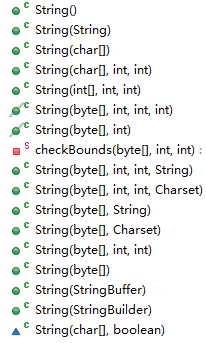String类的源码分析
之前面试的时候被问到有没有看过String类的源码,楼主当时就慌了,回来赶紧补一课。
1.构造器(构造方法)
String类提供了很多不同的构造器,分别对应了不同的字符串初始化方法,此处从源码中摘录如下:

其中蓝色的实心三角表示no modifier(没有修饰符,friendly),表示只能被同一个包中的所有类访问,而不同包中的类不能访问。
这里举了一些示例,来说明这些构造器的用法:
String string = new String();
System.out.println(string.isEmpty());

String string = new String("hello world");
System.out.println(string);

char[] arr = {'A','B', 'C', '1', '2', '3'};
String arrString = new String(arr);
System.out.println(arrString);

char[] arr = {'A','B', 'C', '1', '2', '3'};
String arrString = new String(arr, 1, 4);
System.out.println(arrString);

int[] codepoints = {101, 97, 98, 99};
String string = new String(codepoints, 0, 3);
System.out.println(string);

StringBuffer buffer = new StringBuffer("hello");
2 buffer.append(" world");
3 String string = new String(buffer);
4 System.out.println(string);

StringBuilder builder = new StringBuilder("hello");
builder.append(" world");
String string = new String(builder);
System.out.println(string);

这里提到构造器,笔者想补充一个问题:构造器真的没有返回值吗?既然没有返回值,那么为什么不能用void关键字来修饰?
解析:其实这只是Java语法上的一个规定。实际上,类的构造器是有返回值的,当我们用new关键字来调用构造器时,会返回一个该类的实例对象,并将这个实例对象在堆内存中的地址赋给了一个该类类型的引用变量。因此,构造器的返回值类型总是当前类,所以就无须定义返回值类型。但必须注意的是,不能在构造器里显式地使用return关键字来返回当前类的对象,因为构造器的返回值是隐式的。
2.成员方法
- charAt(int index) 返回字符串中下标为index的字符,返回值为char型
String string = new String("hello world");
System.out.println(string.charAt(0));

- codePointAt(int index) 返回下标为index的字符的unicode码
- codePointBefore(int index) 返回下标为index-1的字符的unicode码
- codePointCount(int beginIndex, int endIndex) 返回下标从beginIndex到endIndex的字符数
String string = "hello world";
System.out.print(string.charAt(4)+" ");
System.out.println(string.codePointAt(4));
System.out.print(string.charAt(4)+" ");
System.out.println(string.codePointBefore(5));
System.out.println(string.codePointCount(0, 6));

- equals(Object obj) 比较两个字符串是否相同,返回值为true或者false,此外还有equalsIgnoreCase(String anotherString),即忽略大小写的比较
注意:1.字符串之间的比较时,比较的是字符串的内容而不是地址,并且只能用于比较String类型,因为StringBuffer和StringBuilder都没有equals()方法;
2.非字符串之间的比较时,比较的是引用的地址而不是内容,可以用于StringBuffer和StringBuilder类型。
String string = "hello";
System.out.println(string.equals("hello")); //true String s1 = "hello";
System.out.println(string.equals(s1)); //true String s2 = new String("hello");
String s3 = new String("hello");
System.out.println(s2.equals(s3)); //true /* 注意:StringBuffer和StringBuilder都没有equals()方法
所以调用equals()方法时,比较的是引用变量的地址,所以结果均为false*/
StringBuffer s4 = new StringBuffer("hello");
StringBuilder s5 = new StringBuilder("hello");
StringBuffer s6 = new StringBuffer("hello");
StringBuilder s7 = new StringBuilder("hello");
System.out.println(s1.equals(s4)); //false
System.out.println(s2.equals(s5)); //false
System.out.println(s4.equals(s5)); //false
System.out.println(s4.equals(s6)); //false
System.out.println(s5.equals(s7)); //fals
String string = "hello";
System.out.println(string.equalsIgnoreCase("Hello")); //true
- toCharArray() 字符串转换为数组,返回值为一个char类型的数组
注意:字符数组转换为字符串可以用构造器String(char[]) 实现
String string = "hello world";
char[] charArr = string.toCharArray();
for(char ch: charArr){
System.out.print(ch+" ");
}

- 此外,String类还有很多成员方法,这里简单列举一些常用的:
startsWith(String prefix) endsWith(String suffix) indexOf(int ch) indexOf(int ch, int fromIndex) lastIndexOf(int ch) lastIndexOf(int ch, int fromIndex) indexOf(String str) indexOf(String str, int fromIndex) substring(int beginIndex) substring(int beginIndex, int endIndex) replace(char oldChar, char newChar) matches(String regex) contains(CharSequence s) replaceAll(String regex, String replacement) split(String regex) toLowerCase() toUpperCase() trim()
String类的源码分析的更多相关文章
- JDK中String类的源码分析(二)
1.startsWith(String prefix, int toffset)方法 包括startsWith(*),endsWith(*)方法,都是调用上述一个方法 public boolean s ...
- JDK中String类的源码分析(一)
1.String类是final的,不允许被继承 /** The value is used for character storage. */ private final char value[]; ...
- Spring-MongoDB 关键类的源码分析
本文分析的是 spring-data-mongodb-1.9.2.RELEASE.jar 和 mongodb-driver-core-3.2.2.jar. 一.UML Class Diagram 核心 ...
- Set集合架构和常用实现类的源码分析以及实例应用
说明:Set的实现类都是基于Map来实现的(HashSet是通过HashMap实现的,TreeSet是通过TreeMap实现的). (01) Set 是继承于Collection的接口.它是一个不允许 ...
- String,StringBuffer,StringBuilder源码分析
1.类结构 String Diagrams StringBuffer Diagrams StringBuilder Diagrams 通过以上Diagrams可以看出,String,StringBuf ...
- Mybatis Mapper接口是如何找到实现类的-源码分析
KeyWords: Mybatis 原理,源码,Mybatis Mapper 接口实现类,代理模式,动态代理,Java动态代理,Proxy.newProxyInstance,Mapper 映射,Map ...
- java类uuid源码分析
通用唯一识别码(英语:Universally Unique Identifier,简称UUID)是一种软件建构的标准,亦为自由软件基金会组织在分散式计算环境领域的一部份.UUID的目的,是让分散式系统 ...
- 【Cocos2d-x 3.x】 动作类Action源码分析
游戏设计中,动作是不可缺少的,Cocos2d-x中所有的动作都继承自Action类,而Action类继承自Ref和Clonable类,整个动作类继承体系如图: FiniteTimeAction是所有瞬 ...
- String、StringBuffer、StringBuilder源码分析
利用反编译具体看看"+"的过程 1 public class Test 2 { 3 public static void main(String[] args) 4 { 5 int ...
随机推荐
- 使用webpack热加载,开发多页面web应用
我们一般使用webpack热加载开发SPA应用,但工作中难免会遇到一些多页面的demo或项目. 故参考 kingvid-chan 的代码,搭了一个使用HRM开发多页面web应用的脚手架,刚好也进一步学 ...
- asp.net MVC Ajax.BeginForm 异步上传图片的问题
当debug到这里,你们就发现不管是 Request.Files["Upload"]亦或 Request.Files[0] 都不会取到文件流. 这就是我要说的,当使用Ajax.Be ...
- NOIP[2015] Day2题解
问题 A: 跳石头 时间限制: 1 Sec 内存限制: 128 MB 题目描述 一年一度的"跳石头"比赛又要开始了! 这项比赛将在一条笔直的河道中进行,河道中分布着一些巨大岩石. ...
- Python 的经典入门书籍有哪些?
是不是很多人跟你说,学Python开发就该老老实实地找书来看,再配合死命敲代码?电脑有了,软件也有了,心也收回来了?万事俱备,唯独只欠书籍?没找到到合适的书籍?可以看看这些. 1.Python基础教程 ...
- ElasticSearch和Kibana 5.X集群的安装
ElasticSearch和Kibana 5.X集群的安装 1.准备工作 1.1.下载安装包 1.2.系统的准备 2.ElasticSearch集群的安装 2.1.修改 config/elastics ...
- 极化码的matlab仿真(2)——编码
第二篇我们来介绍一下极化码的编码. 首先为了方便进行编码,我们需要进行数组的定义 signal = randi([0,1],1,ST); %信息位比特,随机二进制数 frozen = zeros(1, ...
- Servlet和JSP生命周期概述
详见:http://blog.yemou.net/article/query/info/tytfjhfascvhzxcyt374 Servlet生命周期分为三个阶段: 1,初始化阶段 调用init( ...
- Winform控件输入的字母转换成大写
private void textBoxHbh_KeyPress(object sender, KeyPressEventArgs e) { if (e.KeyChar >= 'a' & ...
- NHibernate教程(11)--多对多关联查询
本节内容 多对多关系引入 多对多映射关系 多对多关联查询 1.原生SQL关联查询 2.HQL关联查询 3.Criteria API关联查询 结语 多对多关系引入 让我们再次回顾在第二篇中建立的数据模型 ...
- 在配置github中遇到的一些问题
这次在配置github时,我出现了问题,就是在我装好Git以后,我打开Git Bash,输入了这句代码:$ ssh-keygen -t rsa -C "your_email@youremai ...
